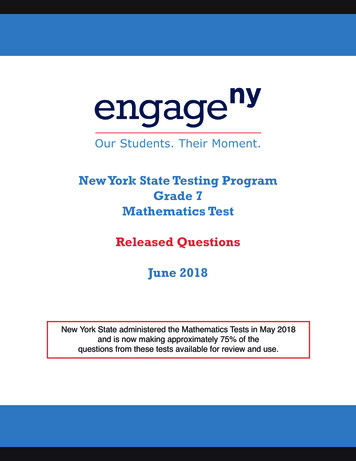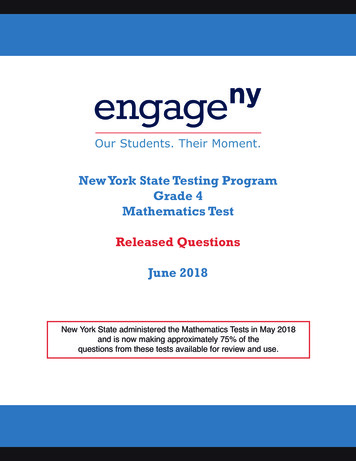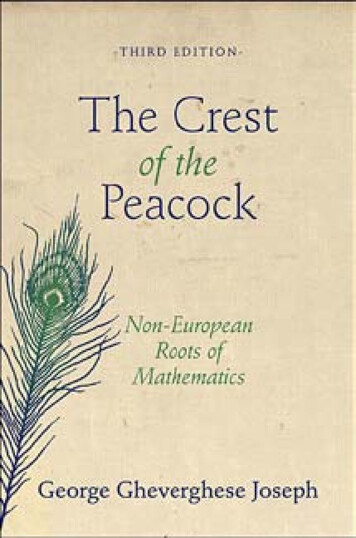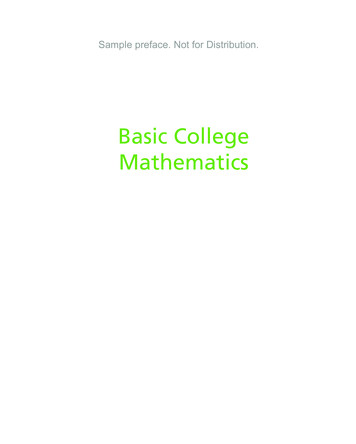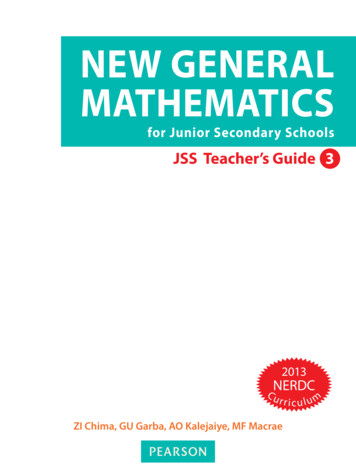
Transcription
NEW GENERALMATHEMATICSfor Junior Secondary SchoolsJSS Teacher’s Guide 32013NERDCCurriculumZI Chima, GU Garba, AO Kalejaiye, MF Macrae
Pearson Education LimitedEdinburgh GateHarlowEssex CM20 2JEEnglandand Associated Companies throughout the world Pearson Education Limited 2014 All rights reserved. No part of this publication may be reproduced,stored in a retrieval system or transmitted in any form or by any means,electronic, mechanical, photocopying, recording, or otherwise, withoutthe prior permission of the publishers.First published in 2014ISBN 9781447978343It is illegal to photocopy any page of this book without the writtenpermission of the copyright holder.Cover design by Dion RushovichTypesetting by MartingraphixAcknowledgements:The Publishers would like to thank the following for the use ofcopyrighted images in this publication:Cover photo/artwork from Carol and Mike Werner/ Alamy / AfripicsA09T98Every effort has been made to trace the copyright holders. In the event ofunintentional omissions or errors, any information that would enable thepublisher to make the proper arrangements will be appreciated.
IntroductionThis is the first time in two decades that a teacher’s component has been prepared for theNew General Mathematics series, which previously consisted of the Student’s Book andthe Student’s Practice Book. In this revision, the Student’s Practice Book has been calledthe Workbook. This Teacher’s Guide supports the New General Mathematics for JuniorSecondary Schools 1–3 series as revised to align to the 2013 NERDC curriculum.The Teacher’s Guide contains: information on how to use the course as a whole a suggested scheme of work for the year and a curriculum matching chart additional chapters that were not included in the Student’s Book. You can use these withyour class, as time permits suggested lesson plans of how to break each chapter down into teachable portions, as wellas notes on foundation knowledge required and assessment milestones printable test papers for the chapter revision and term revision tests answers for the puzzle corners, Chapter revision tests, and term revision tests, which weredeliberately excluded from the Student’s Book workbook marking sheets.We hope that you will find this guide a useful resource for you as a teacher. We welcome anycomments or suggestions you may have, and ask you to direct your comments through thepublisher, using our website address www.pearsonnigeria.com.Introductioniii
ContentsIntroduction. . . . . . . . . . . . . . . . . . . . . . . . . . . . . . . . . . . . . . . . . . . . . . . . . . . . . . . . . . . . . . . . . . . . . . . . . . .iiiJSS3 Scheme of Work and Curriculum Matching Chart. . . . . . . . . . . . . . . . . . . . . . . . . . . . . . . . . . . . . . . . .vMethodology and Features of the Student Book, Teacher’s Guide and Workbook . . . . . . . . . . . . . . . . . . . .ixSection 1: Additional material. . . . . . . . . . . . . . . . . . . . . . . . . . . . . . . . . . . . . . . . . . . . . . . . . . . . . . . . . . . . .1Preliminary chapter: Review of previous coursework . . . . . . . . . . . . . . . . . . . . . . . . . . . . . . . . . . . . . . . . . .2Enrichment chapter: ICT and computers. . . . . . . . . . . . . . . . . . . . . . . . . . . . . . . . . . . . . . . . . . . . . . . . . . .14Section 2: Lesson plans. . . . . . . . . . . . . . . . . . . . . . . . . . . . . . . . . . . . . . . . . . . . . . . . . . . . . . . . . . . . . . . . . . .20Chapter 1 Binary system: Operations and applications. . . . . . . . . . . . . . . . . . . . . . . . . . . . . . . . . . . . . . . . .21Chapter 2 Word problems. . . . . . . . . . . . . . . . . . . . . . . . . . . . . . . . . . . . . . . . . . . . . . . . . . . . . . . . . . . . . . .23Chapter 3 Factorisation 1: Common factors. . . . . . . . . . . . . . . . . . . . . . . . . . . . . . . . . . . . . . . . . . . . . . . . .25Chapter 4 Geometrical constructions . . . . . . . . . . . . . . . . . . . . . . . . . . . . . . . . . . . . . . . . . . . . . . . . . . . . . .27Chapter 5 Area of plane shapes. . . . . . . . . . . . . . . . . . . . . . . . . . . . . . . . . . . . . . . . . . . . . . . . . . . . . . . . . . .29Chapter 6 Formulae: Substitution; change of subject . . . . . . . . . . . . . . . . . . . . . . . . . . . . . . . . . . . . . . . . . .31Chapter 7 Similarity 1: Similar shapes and scale factors . . . . . . . . . . . . . . . . . . . . . . . . . . . . . . . . . . . . . . . .33Chapter 8 Trigonometry 1: Tangent of an angle . . . . . . . . . . . . . . . . . . . . . . . . . . . . . . . . . . . . . . . . . . . . . .35Chapter 9 Factorisation 2: Quadratic expressions . . . . . . . . . . . . . . . . . . . . . . . . . . . . . . . . . . . . . . . . . . . . .37Chapter 10 Equations 1: Equations with fractions . . . . . . . . . . . . . . . . . . . . . . . . . . . . . . . . . . . . . . . . . . . .40Chapter 11 Compound interest . . . . . . . . . . . . . . . . . . . . . . . . . . . . . . . . . . . . . . . . . . . . . . . . . . . . . . . . . .42Chapter 12 Similarity 2: Area and volume of similar shapes . . . . . . . . . . . . . . . . . . . . . . . . . . . . . . . . . . . . .44Chapter 13 Proportion: Direct; inverse; reciprocal . . . . . . . . . . . . . . . . . . . . . . . . . . . . . . . . . . . . . . . . . . . .46Chapter 14 Equations 2: Simultaneous linear equations . . . . . . . . . . . . . . . . . . . . . . . . . . . . . . . . . . . . . . . .48Chapter 15 Trigonometry 2: Sine and cosine of angles . . . . . . . . . . . . . . . . . . . . . . . . . . . . . . . . . . . . . . . . .50Chapter 16 Everyday statistics . . . . . . . . . . . . . . . . . . . . . . . . . . . . . . . . . . . . . . . . . . . . . . . . . . . . . . . . . . .52Chapter 17 Rational and non-rational numbers . . . . . . . . . . . . . . . . . . . . . . . . . . . . . . . . . . . . . . . . . . . . . .54Section 3: Revision tests . . . . . . . . . . . . . . . . . . . . . . . . . . . . . . . . . . . . . . . . . . . . . . . . . . . . . . . . . . . . . . . . .56Chapter revision test sheets. . . . . . . . . . . . . . . . . . . . . . . . . . . . . . . . . . . . . . . . . . . . . . . . . . . . . . . . . . . . . .57Chapter revision test answers. . . . . . . . . . . . . . . . . . . . . . . . . . . . . . . . . . . . . . . . . . . . . . . . . . . . . . . . . . . . .87Term revision test sheets. . . . . . . . . . . . . . . . . . . . . . . . . . . . . . . . . . . . . . . . . . . . . . . . . . . . . . . . . . . . . . . .90Term revision test answers. . . . . . . . . . . . . . . . . . . . . . . . . . . . . . . . . . . . . . . . . . . . . . . . . . . . . . . . . . . . . . . 116Section 4: Workbook answer sheets. . . . . . . . . . . . . . . . . . . . . . . . . . . . . . . . . . . . . . . . . . . . . . . . . . . . . . . . . 118IndexivContents. . . . . . . . . . . . . . . . . . . . . . . . . . . . . . . . . . . . . . . . . . . . . . . . . . . . . . . . . . . . . . . . . . . . . . . . . . . . . . 179
JSS3 Scheme of Work and Curriculum matching chartThe chart on the following pages also appearsin the Students’ Book. It combines a Scheme ofWork for JSS3 with corresponding themes andobjectives that appear in the current NERDC basicmathematics curriculum for Junior Secondaryschools.Scheme of WorkThe Scheme of Work appears in the three left-handcolumns of the chart. The scheme follows thechapter order of New General Mathematics JSSStudent's Book 3 and is based on an average schoolterm of ten effective teaching weeks. For Terms 1and 2, the chapters in the book have been carefullyarranged in a sequence that combines a logicalcoverage of the curriculum topics with a spiralapproach to learning. By spiral approach, we meanthat instead of treating a curriculum theme (suchas algebra) all at once, the chapters return to atheme during Terms 1 and 2, enabling step-by-steplearning so as to develop competence and capacityover time. Term 3 is devoted to whole–courserevision. In this case it is more appropriate to revisethe course theme by theme.Note that the Scheme of Work makes allowancefor end-of-term revision and testing, an importantcomponent of the school year.The chapter order provides a sound and carefullythought-out Scheme of Work. However, otherschemes are perfectly possible. Your school, districtor State may have a preferred approach. We advisethat you follow the official scheme where it exists.Otherwise, simply follow the chapter order of NewGeneral Mathematics JSS Student's Book 3.In Section 1 of this Teacher's Guide there is anenrichment chapter: ICT and computers. Thischapter is only appropriate if students have accessto computers and a relevant spreadsheet program.Refer to this chapter if possible, bearing in mindthat it is not examinable at JSCE level.Curriculum matching chartThe two right-hand columns of the chart showhow, in Terms 1 and 2, the chapters of New GeneralMathematics JSS Student's Book 3 match with theNational Curriculum as published by NERDC in2013. The first column shows the five curriculumthemes and related topics and the page number inthe NERDC curriculum where they may be found.The curriculum themes are: Number and numeration Basic operations Algebraic processes Mensuration and geometry Everyday statisticsThe final column contains related curriculumperformance objectives.Together, these columns show that NewGeneral Mathematics JSS Student's Book 3 fullycovers the NERDC curriculum. However, due tospace restrictions, NERDC references have beenabbreviated. We advise that you refer to the full36-page Mathematics Curriculum document(NERDC, 2013).We wish to draw your attention to theperformance objectives. The objectives state whatstudents should be able to do after they have beentaught a topic. Objectives are spelled out in fullat the beginning of each chapter of New GeneralMathematics and are reflected in the ChapterSummary that appears at the end of the chapter.Each chapter contains an end–of–chapter test tohelp you to measure student attainment of theobjectives.JSS 3 Scheme of Work and Curriculum matching chartv
Scheme of Work: JSS3, Term 1NGMWorksheetChapter titleTERM 1Ch nonoCurriculum matchingNERDC JSS3Themes and TopicsWeek 1 Pre 1Review ofpreviouscourseworkContent summary relating toNERDC performanceobjectives for JSS1 and JSS2Week 2 Ch 1Binary system: 1OperationsandapplicationsNumber and numerationBasic operationsAlgebraic processesMensuration and geometryEveryday statisticsNumber & Numeration, p. 28Sub-theme: Whole numbersTopic 1: Whole numbersWeek 3 Ch 2Wordproblems2Week 4 Ch 3Factorisation1: Commonfactors3Week 5 Ch 4Construction4Week 6 Ch 5Area of planeshapes5Week 7 Ch 6Formulae:Substitution,change ofsubjectSimilarity 1:Place shapes,scale factor67Mensuration & Geometry,p. 33Sub-theme: ShapesTopic 1: Similar shapesTrigonometry1:Tangent of anangle8Mensuration & Geometry,p. 33Sub-theme: ShapesTopic 2: TrigonometryIdentify similar plane figures(triangles, rectangles, squares)in the environmentEnlarge a shape by a givenscale factorDetermine the tangent of anacute angleApply the tangent ratio tofinding distances, lengths andanglesWeek 8 Ch 7Week 9 Ch 8Week Revision Exercises andTests, Ch 1 - 810End of Term 1viJSS 3 Scheme of Work and Curriculum matching chartNERDC JSS3Performance ObjectivesRecall and use binary numberoperationsConvert binary numbers toother bases and vice versaSolve QR problems on binarysystemsBasic Operations, p. 30Topics 1 – 4 Operations with Add, subtract, multiplynumbers in base twobase two numeralsNumber & Numeration, p. 28 Translate word problems intoSub-theme: Whole numbers numerical expressionsTopic 1: Whole numbersFactorise simple algebraicAlgebraic Processes, p. 31expressionsSub-theme: AlgebraicSolve word problemsoperationsinvolving factorisationTopic 1: FactorisationRevise line and angleMensuration & Geometry,bisectionp. 35Construct angles of 90 , 45 ,Sub-theme: Shapes60 , 30 Copy a given angleTopic 5: ConstructionConstruct simple shapesFind the area of triangles,Mensuration & Geometry,parallelograms, trapeziums,p. 34circles, sectorsSub-theme: ShapesTopic 5: Area of plane figures Solve word and QR problemson area (in the home, theenvironment and in relationto land measure)Algebraic ProcessesSubstitute values in a formulaChange the subject of aformulaUse revision exercises and tests to consolidate Term 1 content
Scheme of Work: JSS3, Term 2NGMWorksheetChapter titleTERM 2Ch nonoCh 9Factorisation 2: 9QuadraticexpressionsCh 10Equations 1:Equationswith fractions10Week 3Ch 11Compoundinterest11Week 4Ch 12Similarity 2:Area andvolume ofsimilar shapes12Week 5Ch 1313Proportion:Direct, inverse,reciprocalWeek 6Ch 14Equations 2:SimultaneouslinearequationsWeek 7Ch 15Trigonometry 2: 15Sine andcosine ofanglesWeek 8Ch 16EverydaystatisticsWeek 1Week 21416Curriculum matchingNERDC JSS3Themes and TopicsNERDC JSS3Performance ObjectivesFactorise quadraticexpressionsSolve word problemsinvolving factorisationSolve simple equationsinvolving fractionsSolve word problems leadingto equations involvingfractionsSolve compound interestproblemsApply the use of compoundinterest in daily life activitiesCalculate lengths, areas andMensuration & Geometry,volumes of similar shapesp. 33Use scale factor (k, k2, k3) inSub-theme: Shapesrelation to areas and volumesTopic 1: Similar shapesof similar shapesNumber & Numeration, p. 29 Solve problems involvingSub-theme: Whole numbers direct and inverse proportionApply direct and inverseTopic 1: Whole numbersproportions to practicalproblemsCompile tables of valuesAlgebraic Processes, p. 32Solve simultaneous linearSub-theme: Algebraicequations graphicallyoperationsTopic 3: Simultaneous linear Solve simultaneous equationsusing elimination andequationssubstitution methodsApply methods of solvingsimultaneous equations toreal life activitiesIdentify and determine theMensuration & Geometry,sine and cosine of acutep. 33anglesSub-theme: ShapesApply the sine, cosine andTopic 2: Trigonometrytangent ratios to findingdistances, lengths and angles,and solving word problemsFind mean, median, modeEveryday Statistics, p. 36Topic 1: Measures of central and range of given dataRepresent and interprettendencyinformation in tables andTopic 2: Data presentationon pie charts, bar charts andpictogramsApply everyday statistics toanalysis of information/dataand environmental issuesAlgebraic Processes, p. 31Sub-theme: AlgebraicoperationsTopic 1: FactorisationAlgebraic Processes, p. 31Sub-theme: AlgebraicoperationsTopic 2: Simple equationsinvolving fractionsNumber & Numeration, p. 29Sub-theme: Whole numbersTopic 1: Whole numbersJSS 3 Scheme of Work and Curriculum matching chartvii
Week 9Ch 17Rational andnon-rationalnumbers17Number & Numeration, p. 29 Identify and distinguishbetween rational and nonTopic 2: Rational and nonrational numbersrational numbersDetermine approximatevalues of pi (π) and squarerootsWeekRevision Exercises andTests, Ch 9 - 1710End of Term 2Scheme of Work: JSS3, Term 3Whole Course RevisionNGMChapter titleTERM 3Ch noUse revision exercises and tests to consolidate Term 2 contentCurriculum matchingNERDC JSS3Themes and TopicsNERDC JSS3Performance ObjectivesNumber & Numeration(all topics JS1 to JS3)Basic Operations(all topics JS1 to JS3)Algebraic processes(all topics JS1 to JS3)NERDC Performance Objectivesin number and numeration, andbasic operations for JS1 to JS3Weeks1 and 2Ch R1Number &numeration andBasic operationsWeeks3 and 4Ch R2Algebraic processesWeeks5 and 6Ch R3Mensuration andgeometryMensuration and Geometry(all topics JS1 to JS3)Weeks7 and 8Ch R4Everyday statisticsEveryday Statistics(all topics JS1 to JS3)Weeks9 and10JSCEPrepJSCE PracticeExaminationsNumber and numerationBasic operationsAlgebraic processes Mensurationand geometryEveryday statisticsNumber & Numeration, p. 29Sub Theme: Whole numbersTopic 1: Whole numbersEnAsrequiredICT and computersNERDC Performance Objectivesin algebraic processes for JS1 toJS3NERDC Performance Objectivesin mensuration and geometry forJS1 to JS3NERDC Performance Objectivesin everyday statistics for JS1 toJS3NERDC Performance Objectivesfor JS1, JS2 and JS3 Practice in examinationstechniquesUse a computer to do simplemathematical calculationsEnd of Term 3JSCE ExaminationNote: QR means Quantitative Reasoning (ability to cope with numbers and calculation)viii JSS 3 Scheme of Work and Curriculum matching chart
Methodology and features of the Student's Book,Teacher’s Guide and WorkbookFeatures of the Student's BookThe New General Mathematics JSS Student's Book3 consists of 17 chapters. Each chapter startswith a list of objectives, or commonly known asperformance objectives (as listed in NERDC,2013), that will be covered in each chapter.In addition, the exercises in the Student’s Bookhave been carefully developed to ensure integrationof the performance objectives from the curriculum,and a steady progression of skills throughout theyear. The Curriculum Matching Chart and Schemeof Work provides a suggested order for you to follow.The chapters follow a ‘teach and practise’ approach: Teaching and learning materials, includingwhat students and teachers should bring toeach lesson, are suggested. While it is notalways possible to provide everything listed,it is essential that every student has at least anexercise book, a pen, a drawing set and, whenappropriate, graph paper. New concepts are explained and given context intheir meaning. A full glossary is included at theback of the Student’s Book as well. Worked-through examples provide studentswith guidelines and models for setting outmathematical work. In some cases, we haveadded mark schemes to show students andteachers how marks are earned.Exercises allow students to practise on their own.Exercises are graded by writing the questionnumbers in three different ways:1. You must do all of these questions if you areto understand the topic.2. You should do these questions if possible.3. If you want a challenge, then you could dothese questions.At the end of each chapter is a chapter summary,which lists the main learning outcomes studentsneed to achieve.Revision exercises round off each chapter as amixed exercise covering all the problems addressedin the chapter.Summative assessment activities are providedat the end of every term in the three Revisionchapters.These assessments test students on all theknowledge and skills they have gained in each term.Additional features include: Key words: Key terminology, with definitions, ishighlighted for the students. Puzzle corners: Additional problems, usually in areal-life context to help grow an appreciation ofMathematics in everyday life.Quantitative reasoning [QR]Where you see QR beside an exercise or a question,this stands for Quantitative reasoning. Studentsshould do and discuss these questions with youand their classmates. They give special practice atimproving the students’ number work and theirability to calculate.Features of the Teacher’s GuideThis New General Mathematics JSS Teacher's Guide3 is lesson-based. The chapters of the Student’sBook are organised into a series of lessons. Chaptersinclude the following features: The performance objectives from the curriculumthat are covered in the chapter A list of suggested resources you will need Definitions for the key words in the Student’sBook Foundation knowledge students need at the startof the chapter Suggested focus for each lesson Answers to the Puzzle corners and Workbook Assessment notes on how to evaluate students onkey learning milestones.The intention behind the puzzle corners is toprovide students and the teachers with somechallenges that both can engage in. Many of thepuzzles are open-ended and therefore do not havea ‘final answer’. Think of them as a journey ratherthan a destination, i.e. a process, not a product.Methodology and Features of the Student's Book, Teacher’s Guide and Workbookix
To save space we have not included solutions thatrequire extensive artwork. However, the authors arehappy to engage with readers if they care to get intouch with them via the publisher.Note: The lesson-based guidelines are suggestionsonly. You, as the teacher, will need to assess howmuch your students are able to cover in each lesson.Additional Preliminary or Enrichment chapters arealso provided if you have additional teaching time.These can be done at any point during the year, asyou feel necessary.The Teacher’s Guide also includes resources fortesting and marking: Chapter revision test sheets: these are printabletest sheets that you can use for formally assessingyour class. They are based on the chapter revisiontests at the end of each chapter. Chapter revision test answers: the answers forall the chapter revision tests are provided in theTeacher’s Guide. Term revision test sheets: these are printable testsheets that you can use for formally assessingyour class. They are based on the term revisiontests at the end of each term. Term revision test answers: these are answersthat you can use as a guide to formally assessyour class. These answers are based on the termrevision tests at the end of each term. Workbook answer sheets: the answers to theWorkbook are given in the form of completedworksheets, with the answers filled in. Thesecan be used as marking memoranda for theworksheets.Features of the WorkbookThe New General Mathematics JSS Workbook3 provides a worksheet for every chapter in theStudent’s Book. Students use these worksheetsto practise the specific mathematical skills andconcepts covered in each chapter. It forms as aconsolidation of the students’ understanding and isa useful resource for homework assignments.Students can record their answers andcalculations in the spaces provided on each of theworksheets. The answers to these worksheets are allprovided in the Teacher’s Guide.xMethodologyMathematics teaching and learning goes beyondreaching the correct answer. Many mathematicalproblems have a range of possible answers. Studentsneed to understand that Mathematics is a toolfor solving problems in the real world; not justabout giving the correct answers. The Mathematicsclassroom must therefore provide an environmentin which problem-solving is seen as integral to theteaching programme, and where learning activitiesare designed to provide students with opportunitiesto think.Working mathematically involves: questioning applying strategies communicating reasoning reflecting.Alongside developing the necessary problemsolving skills and strategies, the New GeneralMathematics Junior Secondary 3 Teacher’s Guidefocuses on students to gain specific mathematicalknowledge as tools for problem-solving. At JuniorSecondary 3, these tools include: Revising basic operations in binary system Converting numbers in binary numbers to otherbases and vice versa Using a computer to do simple mathematicalcalculations Translating word problems into numericalexpression Simplifying expressions involving bracketsfractions Applying direct and inverse proportions topractical problems Applying the use of compound interest in dailylife activities Identifying rational and non-rational numbers Adding two or three 3-digit binary numbers Subtracting two 3-digit binary numbers Multiplying two 2-digit binary numbers Dividing two 2-digit binary numbers Factorising simple algebraic expressions Factorising quadratic algebraic expressions usingquadratic equation box Compiling table of values for simultaneous linearfunctionsMethodology and Features of the Student's Book, Teacher’s Guide and Workbook
Applying the elimination and substitutionmethods Identifying similar figures: triangles, rectangles,squares, cubes and cuboids Identifying the presence of similar shapes in theenvironment Enlarging figures using scale factors Calculating lengths, areas and volumes of similarfigures Identifying sine, cosine, and tangent of an acuteangle Applying trigonometric ratios when solvingproblems Finding the area of triangles, parallelograms, atrapezium, and circles and sectors Constructing angles of 30 and 45 Using a pair of compasses to copy a given angle Constructing simple shapes Reviewing work on mean, mode and median Calculating the median of given data Finding the mode of given data Calculating the mean on any given data Finding the range of any given data Applying measures of central tendency to analyseany given information Representing and interpreting information onpie charts.Puzzle Corners: Strategies, Solutions,AnswersWhy include Puzzle Corners?The inclusion of puzzle corners is to promote theidea that mathematics is not always about ‘gettingthe right answer’. In many cases mathematics is ajourney, where we sometimes go along pathwaysthat lead nowhere, or, hopefully more often, thatlead to expected and even unexpected discoveries.Think of mathematics as a process, not a product or as a journey, not a destination.It is not always necessary to use conventionalmethods. There are various strategies that oftenhelp (in real life as well as in mathematics). Forexample, you can tell your students to try thefollowing approaches: Trial and improvement [sometimes called trialand error]Make a guess at the solution and see if it works.If it doesn’t, refine your first guess and try again,aiming to get closer to the desired result. This isa perfectly legitimate thing to do. Try a simpler version of the problemInstead of jumping in at the deep end, try thepuzzle with easier numbers or reduced options.You will find some examples below. Use knowledge of numbers, geometry andalgebra where appropriateDon’t devalue what you already know and havelearned in class!In order to promote discussion between users ofNew General Mathematics (teachers and students)and where possible between users and the authors,we have provided a selection of solutions, partialsolutions and answers to the puzzle corners thatappear in the Students Books.Methodology and Features of the Student's Book, Teacher’s Guide and Workbookxi
Section 1: Additional materialSection 1 provides you with optional chapters that you can use with your class.Preliminary chapters are intended for use as revision and to reinforce foundationknowledge that is needed in the year. You may wish to assign work from this chapter asremedial activities for students who struggle with the main course work.Enrichment chapters are optional chapters that extend the scope of the work done inthe year. If you have time at the end of the year, you can work through this additionalchapter with your students. You may wish to assign work from this chapter to strongerstudents.Section 1: Additional material1
Preliminary chapter: Review of previous courseworkObjectivesBy the end of this chapter the studentshould be able to recall, from Books 1 and2 of New General Mathematics, the factsand methods that relate to the followingthemes: Number and numeration Basic operations Algebraic processes Mensuration and geometry Everyday statistics.Teaching and learning materialsTeacher: Addition and multiplication wall charts;1–100 number square; metre rule, measuringtape,Students: Mathematics setTo make the best use of Book 3 of New GeneralMathematics, readers should be familiar with thecontents of Books 1 and 2. This chapter containsthose themes and topics from Books 1 and 2 thatare necessary to understand Book 3.Number and numerationFor most purposes, we write numbers using thedecimal place value system (Fig. P1). The symbols0, 1, 2, 3, 4, 5, 6, 7, 8, 9 are called digits.hundredstensunitsdecimal pointtenthshundredthsthousandths3 7 6. 2 9 5Fig. P1We use the words thousand, million, billion,trillion for large numbers:2Section 1: Additional material1 thousand1 0001031 million1 000 0001061 billion1 000 000 0001091 trillion1 000 000 000 0001012Similarly we use thousandth, millionth andbillionth, for decimal fractions:1 thousandth 0.00110-31 millionth0.000 00110-61 billionth0.000 000 00110-9When writing large and small numbers, group thedigits in threes from the decimal point, for example:9 560 872 143 and 0.067 482.7 is a whole number that divides exactly intoanother whole number, 28.7 is a factor of 28. 28 is a multiple of 7.A prime number has only two factors, itself and 1.1 is not a prime number. 2, 3, 5, 7, 11, 13, 17 are prime numbers. They continue without end.The prime factors of a number are those factorswhich are prime. For example, 2 and 5 are theprime factors of 40. 40 can be written as a productof prime factors: either 2 2 2 5 40 or, inindex form, 23 5 40.The numbers 18, 24 and 30 all have 3 as afactor. 3 is a common factor of the numbers. Thehighest common factor (HCF) is the largest ofthe common factors of a given set of numbers. Forexample, 2, 3 and 6 are the common factors of 18,24 and 30; 6 is the HCF.The number 48 is a multiple of 4 and a multiple of 6.48 is a common multiple of 4and 6. The lowestcommon multiple (LCM) is the smallest of thecommon multiples of a given set of numbers. Forexample, 12 is the LCM of 4 and 6.In a fraction, one number (the numerator) isdivided by another number (the denominator).
The fraction 5 means 5 8 (Fig. P2).858numeratordividing linedenominatorFig. P2Fractions are used to describe parts of quantities(Fig. P3).Fig. P3The fractions 5 , 10 , and 15 represent the same8 1624amount; they are equivalent fractions. 5 is the10 , andsimplest form of 15 .16824Basic operationsTo add or subtract fractions, change them toequivalent fractions with a common denominator.For example: 2 3 16 19 1 8324242412 - 2 12 - 4 8 1 1681616162To multiply fractions, multiply numerator bynumerator and denominator by denominator.Then write your answer in the simplest form.For example:6 2 3 3 452010To divide by a fraction, multiply by the reciprocalof the fraction. For example:3 8 18 1 3 8 6 48 1 10330305 64 .x % is short for x . 64% means100
Mathematics JSS Student's Book 3 match with the National Curriculum as published by NERDC in 2013. The first column shows the five curriculum themes and related topics and the page number in the NERDC curriculum where they may be found. The curriculum themes are: Number and numeration




